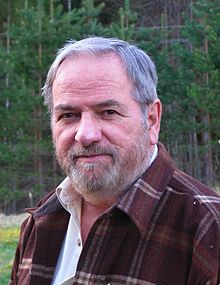This article includes a list of general references, but it lacks sufficient corresponding inline citations. (October 2018) |
John Deely | |
|---|---|
 John Deely (2009) | |
| Born | John Nathaniel Deely 26 April 1942 Chicago, Illinois |
| Died | 7 January 2017 (aged 74) Greensburg, Pennsylvania[1] |
| Alma mater | Saint Vincent College |
| Spouse | Brooke Williams Smith |
| Era | 20th-/21st-century philosophy |
| Region | Western philosophy |
| School | Continental philosophy |
Main interests | Semiotics |
John Deely (April 26, 1942 – January 7, 2017[2]) was an American philosopher and semiotician.[3] He was a professor of philosophy at Saint Vincent College and Seminary in Latrobe, Pennsylvania. Prior to this, he held the Rudman Chair of Graduate Philosophy at the Center for Thomistic Studies, located at the University of St. Thomas (Houston).
His main research concerned the role of semiosis (the action of signs) in mediating objects and things. He specifically investigated the manner in which experience itself is a dynamic structure (or web) woven of triadic relations (signs in the strict sense) whose elements or terms (representamens, significates and interpretants)[4] interchange positions and roles over time in the spiral of semiosis. He was 2006–2007 Executive Director of the Semiotic Society of America.
A number of his works have been published in the journal Advances in Semiotics, including one of his most popular publications, Introducing Semiotics: Its History and Doctrine (1982), as well as Frontiers in Semiotics (1986), edited by Brooke Williams and Felicia Kruse.[5]
- ^ Obituary, Greensburg Tribune Review, January 12, 2017.
- ^ Justin Weinberg (2017-01-12). "John Deely (1942-2017)". Daily Nous. Retrieved 2017-01-29.
- ^ Paul Cobley opined, in Realism for the 21st Century: A John Deely Reader (ed. Cobley), p. 3: "While Charles Sanders Peirce is acknowledged as the greatest American philosopher, John Deely, in his wake, is arguably the most important living American philosopher."
- ^
- "Representamen" (properly with the "a" long and stressed: /ˌrɛprɪzɛnˈteɪmən/ REP-riz-en-TAY-mən), is Charles Sanders Peirce's adopted (not coined) technical term for the sign as covered in his theory. Peirce used the technical term in earlier years in case a divergence should come to light between his theoretical version and the popular senses of the word "sign". Deely argued that the word "sign" is best used for the full triadic relation of representamen, significate object, and interpretant.
- "Significate" and "significate object" are interchangeable in Deely's terminology, and correspond to that which Peirce called the semiotic object or the object. See Deely's The Green Book: The Impact of Semiotics on Philosophy, December 2000. Eprint. The object is that for which the representamen stands, its subject matter.
- "Interpretant" is Peirce's term for a sign's meaning or ramification as formed into a kind of effect which is a further sign, for example a translation.
- ^ Deely, John N; Williams, Brooke; Kruse, Felicia (1986). Frontiers in semiotics. Bloomington : Indiana University Press. ISBN 9780253346056.